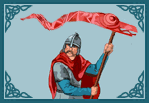 |
 |
|||
|
|
The 9th century Welsh poem, Marwnad Cynddylan ("The Death Song of Cynddylan") and the slightly later Canu Heledd (a lament by Cynddylan's sister, Heledd) give us an interesting insight into the ancestral background of their hero, the early 7th century Cynddylan ap Cyndrwyn, King of Pengwern. The writer laments the slaying of Cynddylan whom he describes as oppressor of the Cadelling. The Cadelling were the family of Cadell Ddyrnllug (of the Gleaming-Hilt), that is the Kings of Powys. So Cynddylan's family were evidently a rival house. Cynddylan is apparently described as a King of Dogfeiling, a sub-kingdom of Gwynedd around Rhuthin. It stands on the northern border of Powys, a stone's throw from the Kingdom of Pengwern. The two were probably adjoining during this period when the Powys Kings were still to annex the area around Wrexham. The Kings of Dogfeiling were of the Gwynedd based House of Cunedda, descendants of his eighth son, Dogfael. Cynddylan's membership of this dynasty is further indicated by references in the poem to the subjects, of what would have been Cynddylan's overlord, who made the writer so welcome across the Menai Straits in the Gwynedd homeland areas of Cemais and its capital, Aberffraw. The children of Cyndrwyn, Cynddylan's twelve brothers and nine sisters are recorded in the Bonedd yr Arwr. Amongst them are Heledd (of course), Morfael who is praised in the Marwnad Cynddylan for his attack on Caer-Luit-Coyt and an interesting figure named Eluan Powys. The Canu Heledd laments the latter's death along with his brother: Dark of Roof is Cynddylan's Hall Eluan's epithet, Powys, indicates that he was strongly associated with this Kingdom and must have been its monarch; but surely the Cadelling were ruling there at this time? Probably not, in fact, for Selyf Sarffgadau (Battle-Snake) had died in the Battle of Caer-Legion (Chester) in 613, leaving a baby son as his heir. It would seem that this young lad was, not surprisingly, unable to hang on to his Kingdom in the face of attacks from the rival dynasty of adjoining Dogfeiling. Cynddylan oppressor of the Cadelling probably helped his brother, Eluan, to usurp the Powysian throne. Thus the latter is found intruding on traditional Powys pedigrees that prseumably derive from mere King lists: Beli ap Eiludd ap Cynan ap Brochfael; and as Elfan he is often confused with Selyf (Sarffgadau) which is sometimes short for Selyfan. Neither Cynddylan nor his father, Cyndrwyn, appear in the traditional pedigree of the Dogfeiling Kings, however Eluan may: Eludd ap Glas ap Elnaw ap Dogfael. But if Eluan were the son of Cyndrwyn, who is Glas? The answer may lie in an old pedigree of the Kings of Glastenning (Somerset). This states that the earliest Kings of this sub-Kingdom of Dumnonia were Morfael and his father, Glast who was "one of those who came to Glastenning from the place called Luit-Coyt". We have already seen that Cynddylan's brother, Morfael was from Caer-Luit-Coyt. Hence it would seem that the father of Cynddylan, Eluan and Morfael was Cyndrwyn alias Glas(t), or perhaps Glas was an epithet: Cyndrwyn Glas (the Blue - possibly from painting his face with woad). He was a King of Dogfeiling who with his sons expanded his Kingdom to include much of Midland Britain. His son, Eluan even overran the mighty Kingdom of Powys. Their ascendancy was short-lived however. When Oswiu of Northumbria invaded and all but wiped out the Dogfeiling brothers, the House of Cadell re-established itself in Powys and only Morfael (and possibly his ageing father) managed to survive to flee to safety in Dumnonia.
|
|||
| © Nash Ford Publishing 2001. All Rights Reserved. | ||||




